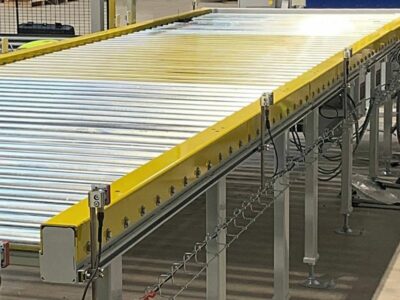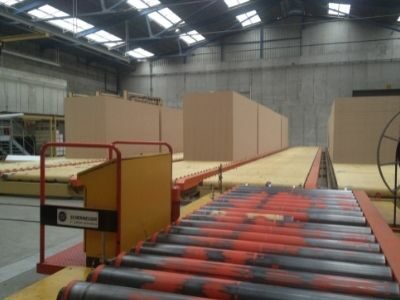Roller conveyor
Stable and smooth handling of your pallets and panels
Discover the roller conveyor
Transport of flat-bottomed products with roller conveyors
Our roller conveyor systems can be motorized or gravity driven. The roller conveyor is an efficient way to move your products through your plant or warehouse. We are also able to provide you with completely customized conveyor solutions. We adapt the roller conveyor solution according to the dimensions of the products you are transporting and the space available in your warehouse.





The roller conveyors we produce allow the movement of packages and stacks of very high height. Thus, we realize different handling solutions. We specialize in products with a very high load and a very robust nature. Our roller conveyors can also transport light products such as pallets or a single panel.
Motorized roller conveyor :
Motorized roller conveyors allow you to fully automate your handling line. The flows are fully automated through your warehouse. Opting for a motorized roller conveyor allows you to integrate a fully automated handling solution that does not require human intervention on the line.



Gravity roller conveyor :
One of the main characteristics of the gravity roller conveyor is that the rollers are not placed on a perfectly horizontal conveyor. The gravity roller conveyor allows you to move your products without the need to motorize the conveyor. In fact, the conveyor is installed in such a way as to obtain a slope of 2 to 5 percent. This solution allows products to be moved in short straight paths without the need for power.


Applications of Roller Conveyor
It is therefore very important when setting up a roller conveyor to determine the dimensions of the object to be transported by the conveyor. The roller conveyor can only transport loads with a flat and rigid bottom. Therefore, it is important to determine the dimensions, the mass, but also the direction of transport of the object to be conveyed.
Once the object and its dimensions have been identified, it is then possible to calculate the distance between the rollers, i.e. the pitch between the rollers and the diameter of the rollers. This allows us to know the number of rollers necessary to convey the objects according to the desired length of conveyance. It also allows us to define the resistance of the rollers which is necessary according to the product that you move.
We can produce roller conveyors in different materials depending on the working environment. For example, for food or medical environments, we produce conveyors in PVC or stainless steel. For more traditional environments, we also produce steel conveyors.
